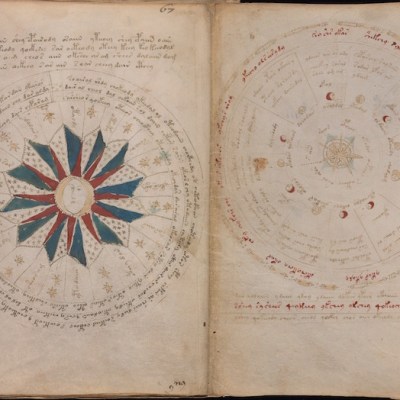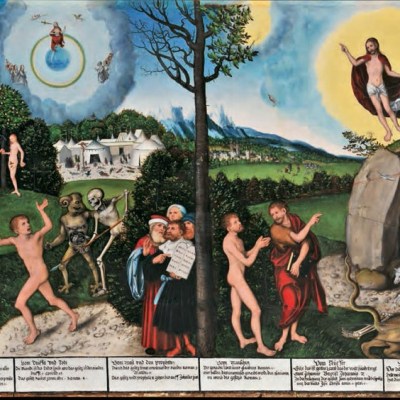Albrecht Dürer’s engraved portrait of Erasmus makes a conventional distinction between the representative power of visual art and writing, apparently favouring Erasmus’s stylus over Dürer’s burin. The Greek legend in the frame behind the scholar reads ‘his writings show his image more vividly’ than can the image itself. Those writings are included in books on the shelf in the foreground, the letter folded by the side of the writing desk, and the activity in which Erasmus is absorbedly engaged. But, the legend suggests, it is the undepicted and undepictable contents of such writings which offer the better portrait of the man.
Dürer implies that visual depiction loses the paragone between poetry and painting, words and images. But the engraving is partially exempt from this defeat – after all, it is composed of both graphic representation and writing. The form of that writing is significant. The frame shows four different systems of signs: Latin and Greek alphabets, Roman numerals, and Dürer’s monogram, a non-representational self-portrait adjacent to the ostensible subject of the print. In Latin, Dürer describes the imago as delineata: delineated, or described through lines. The lines written by Erasmus on his paper, or the serried horizontal ranks of print on the open book, are implicitly compared with the lines engraved by Dürer’s burin. Though he expressed dissatisfaction with this likeness (or lack of it), Erasmus had earlier remarked ‘What cannot Dürer express in monochromes, that is, by black lines only?’ This registers amazement at what Dürer achieved without colour; it also notes how the minimal means of graphic art, its patterns of curved and straight lines forming images and letters, can express thought.
Erasmus of Rotterdam (1526), Albrecht Dürer. Metropolitan Museum of Art, New York

The argument of Susanna Berger’s rich and original The Art of Philosophy also runs counter to Dürer’s modesty, suggesting that ‘the viewing and creation of imagery functioned as important instruments of philosophical thought and teaching’ in the 16th and 17th centuries. The connection between thought and Renaissance visual art is frequently discussed, in exploration of Vasari’s comments on the intellectual quality of disegno, or in studies, such as by Sachiko Kusukawa and Claus Zittel, on the role of images in new philosophies. Implicit in such arguments, however, is the assumption that the traditional Aristotelianism of arts education was visually meagre. Berger demonstrates instead the richness of its visual culture, focusing on ‘the philosophical plural image’. The early modern period sees a shift, she argues, between a medieval conception of images as composed of ‘discrete, individual parts’ combined to create a heterogeneous whole, and a modern tendency to isolated ‘singular images’. ‘Philosophical plural images’ incorporate text to explicate or name depicted entities, and express concepts through geometrical relationships and use of the space of the page, wall, or window, to communicate hierarchy, equivalence, contrast, or succession. They are often allegorical, and imply a sequence in which they must be ‘read’, mapping a progress of reasoning.
Artificiosa totius logices descriptio (Artificial Description of Logic in Its Entirety) (1614), designed by Martin Meurisse and executed by Léonard Gaultier. Bibliothèque royale de Belgique, Cabinet des Estampes, Brussels

The particular stars of this book are the engraved broadsides designed by Martin Meurisse and Jean Chéron, executed by Léonard Gaultier, which graphically represent Aristotelian logic, physics, and metaphysics. These prints, used for teaching in Paris and copied across Europe, depict abstract concepts and relationships, like substance, accident, matter, form, difference, and privation. They are extraordinarily busy: like a Brueghel marketplace, exhaustingly dense with significant detail. Berger’s third chapter is a close explication of their meaning and spatial organisation. It is both a clear account of a discipline which anti-Aristotelian critics accused of barbarous opacity, and a demonstration of the ways in which these fascinating visual objects could be used to render complex material memorable and perspicuous. Berger also shows the role which drawing played for students of a discipline often thought irremediably verbal. Her work on notebooks and alba amicorum reveals impressive archival industry, bringing to light many hitherto unpublished and undiscussed sources.
Attempts to extrapolate from the use of imagery in a scholastic context to a story of all art in Europe before 1800 dilute Berger’s arguments, and betray the particularity of her sources – academic materials largely from France and the Spanish Netherlands. The broad claims bleed out local specificity, and differences in religion (the bulk of her materials are Catholic), artisanal practice, politics, and transformations of educational culture. To claim that the famous frontispiece to Hobbes’s Leviathan exhibits an unexpectedly ‘medieval syntax’ in comparison with contemporary French images, for example, ignores its context in republican London, where print shops were full of allegorical and emblematic title-pages, including that of the Eikon Basilike, published two years earlier and offering an entirely different depiction of sovereignty.
Tableau industrieux de toute la philosophie morale (Artificial Table of Moral Philosophy in Its Entirety) (1618), designed by Martin Meurisse and executed by Léonard Gaultier. Bibliothèque nationale de France, Cabinet des Estampes, Paris

The ambitious scope also drowns out questions which would have added to the argument’s depth. The best illustrations of Berger’s argument come in engravings and manuscript drawings, in monochrome arts where line acts as expression of thought. Nonetheless, Berger does not address the relative epistemic value of line and colour, nor ask whether engraving is privileged as a medium for thought, as Dürer’s example suggests. Berger’s grander claims – ‘all premodern art in Europe involves language, even if script is not literally present’ – would have benefitted from more nuanced consideration of different ways of incorporating or implying text, the importance of the book trade, and of frontispieces other than Leviathan’s as ‘philosophical plural images’. The implications of a model of image-reading in which a tutor’s explication inducts a student into specific disciplinary and institutional fields, and its distinction from the hermeneutic demands of other kinds of allegory, are also elided.
That this book provokes so many lines of inquiry testifies to its topic’s richness. It makes an original contribution to both the intellectual history of the legacies of Aristotelianism, and the vibrant field of the relation between philosophy and visual culture. The generous illustrations make accessible much rare or unpublished material. Like the pedagogical images at the heart of its argument, its business and variety can be confusing. But therein also lies its fascination.
Laurus metaphysica (Laurel of Metaphysics) (1616), designed by Martin Meurisse and executed by Léonard Gaultier. Bibliothèque nationale de France, Cabinet des Estampes, Paris

The Art of Philosophy: Visual Thinking in Europe from the Late Renaissance to the Early Enlightenment, by Susanna Berger, is publisehd by Princeton University Press.
From the July/August issue of Apollo. Preview and subscribe here.



